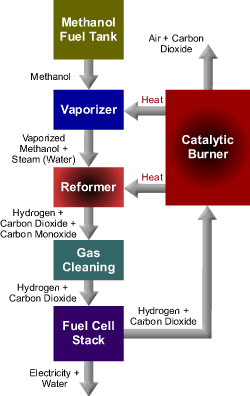|
Powertrain
Fuel Cell Vehicles
Fuel cell
powered vehicles (FCVs) offer a promising new source of clean power
for vehicles. This innovative technology uses chemical energy
rather than combustion to generate electric power, resulting in
fewer emissions and a decrease in dependence of foreign oil.
FCVs represent
a radical departure from vehicles with conventional internal
combustion engines. Like battery-electric vehicles, FCVs are
propelled by electric motors. Fuel cells onboard the vehicle
creates electricity through a
chemical process using hydrogen fuel and oxygen from the air. FCVs
can be fueled with pure hydrogen gas stored onboard in high-pressure
tanks or through hydrogen-rich fuels (methanol, natural gas, or even
gasoline) that are converted into hydrogen gas by an onboard device
called a "reformer." The byproducts of FCVs are water and heat;
while those using hydrogen-rich fuels and a reformer produce only
small amounts of air pollutants. In addition, FCVs can be twice as
efficient as similarly sized conventional vehicles and may also
incorporate other advanced technologies to increase efficiency.
Pure hydrogen
FCVs can be fueled with pure hydrogen gas stored in onboard fuel
tanks. Since hydrogen gas is diffuse, it must be stored in
high-pressure tanks in order to store enough to travel reasonable
distances on a full tank of fuel. Currently used tanks, which allow
hydrogen to be compressed to 5,000 pounds/square inch (psi) of
pressure, can only store enough hydrogen gas to allow FCVs to go
about 200 miles before refueling. However, manufacturers are
designing and testing tanks that will store more hydrogen at a
higher pressure. In addition to onboard storage problems, our
current system for getting liquid gasoline to consumers can't be
used for gaseous hydrogen. Therefore, new facilities and systems
would have to be built, requiring significant time and resources.

Hydrogen-rich
fuels
FCVs can also be fueled with hydrogen-rich fuels, such as methanol,
natural gas, petroleum distillates, or even gasoline. These fuels
must be passed through onboard "reformers" that extract pure
hydrogen from the fuel for use in the fuel cell. The fuels mentioned above contain enough hydrogen to allow FCVs to travel the same distance as a conventional vehicle on a
single tank of gas; about 300 to 400 miles. Also, unlike hydrogen
gas, liquid fuels like methanol and gasoline wouldn't require a
completely new system for delivering fuel to consumers.
Although there
are advantages to powering FCVs with these fuels, there are also
several disadvantages.
-
Onboard
reformers add to the complexity, cost, and maintenance demands
of a vehicle's fuel cell system.
-
If the
reformer allows carbon oxides to reach the fuel cell anode, it
can gradually decrease the performance of the cell.
-
Reformers
produce small amounts of greenhouse gases and other air
pollutants.
|